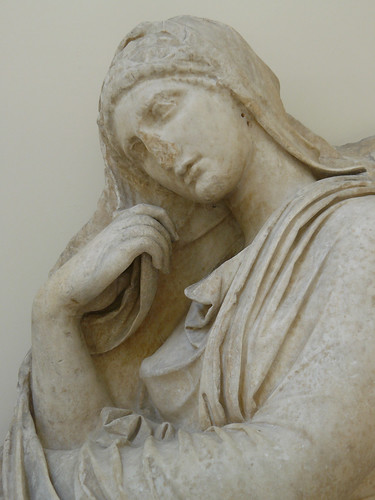
I really need to plan a visit to the Onassis Cultural Center in New York. I wanted to see the exhibit about life in Sparta they hosted a couple of years ago but the Historical Novel Society conference I attended in Albany was scheduled too late. I'm afraid I won't get to see this excellent exhibit either as I'll be just back from Rome in March and would not have enough "recovery" time to turn around and attempt another trip to New York so soon.
[Image - Although this sculpture of a mid-4th century BCE Attic woman from Acharnae Menidi discovered before 1827 is part of the permanent collection of the Metropolitan Museum of Art and is not part of the upcoming exhibit, it typifies the subtle grace and modesty depicted in sculpture of the period. This image is included in my Flickr image archive. I have licensed all images with Creative Commons for free non-commercial use with the attribution "Photo by Mary Harrsch". Any derivatives must also be shared in like manner]
The galleries of the Onassis Cultural Center in New York will be transformed into evocations of ancient Greek sanctuaries, each filled with artistic masterpieces assembled from international collections, for the major exhibition Worshiping Women: Ritual and Reality in Classical Athens. On view from December 10, 2008, through May 9, 2009, the exhibition brings together 155 rare and extraordinary archaeological objects in order to re-examine preconceptions about the exclusion of women from public life in ancient Athens. The story told by these objects, and experienced in the galleries, presents a more nuanced picture than is often seen, showing how women’s participation in cults and festivals contributed not only to personal fulfillment in Classical Greece but also to civic identity.
Among the treasures being brought to New York for the exhibition are marble statues of the goddesses Artemis and Athena (National Archaeological Museum, Athens); a white-ground vase with an image of Artemis, by the Pan Painter (State Hermitage Museum, Petersburg); a red-figure vase with an image of Iphigenia, the legendary heroine worshiped as a cult figure and seen as a model for priestesses (Museo Archeologico Nazionale, Ferrara); a vase showing the Trojan priestess Theano, another model for priestesses, receiving the Greek warriors who had come to recover Helen from Troy (Vatican Museums); and a limestone grave marker (conserved with support from the Onassis Foundation) carved with the image of a young woman in bridal costume, holding a votive offering (State Museums of Berlin). Interspersed with these and other exquisite artworks are archaeological objects that document the religious practices of Classical Athens and tell the complex story of women’s roles in that society.Worshiping Women tells this story in three main chapters. “Goddesses and Heroines” introduces the principal female deities of Athens and Attica, in whose cults and festivals women were most actively engaged: Athena, Artemis, Aphrodite, and Demeter and her daughter Persephone. This first section also investigates the role of heroines, a special group of women believed to have lived in the distant past, who like Iphigenia became important figures of cult worship after their deaths.
The second chapter, “Women and Ritual,” explores the practice of ritual acts such as dances, libations, sacrifices, processions and festivals in which women were active in classical antiquity. Here the critical role of the priestess comes to light, specifically in her function as key-bearer for the temples of the gods.
In the final chapter, “Women and the Cycle of Life,” the exhibition explores how religious rituals defined moments of transition. Because the most important transition in a girl’s life was understood to be marriage, the wedding took on great significance, with its rituals depicted on a variety of vases associated with nuptial rites and wedding banquets. Death was another occasion on which Athenian women took on major responsibilities, such as preparing the deceased for burial and tending the graves of family members.
N.S. Gill's post about the exhibit in her "About Ancient History" blog included a link to a fascinating article about the ancient festival of Thesmophoria. An abstract:
Before the Thesmophoria festival itself, there was a preparatory night-time festival called the Stenia. At the Stenia women engaged in Aiskhrologia, insulting each other and using foul language. This commemorated Iambe's successful attempts to make the grieving mother Demeter laugh.
[This almost sounds like modern antics associated with male bonding!]
During the Stenia portion of the Thesmophoria women may have placed fertility objects, molded bread [in the shape of male genitals], pine cones and piglets, in a snake-filled chamber called a megaron.
The objects were later retrieved and ceremonially carried to an altar during a night time torch-lit procession commemorating Demeter's search for her kidnapped daughter Persephone. Aristophanes' comedic play Thesmophoriazusae tells the story of a man trying to infiltrate the Thesmophoria. Maybe Clodius of Roman fame got his idea to sneak into the celebration of the Bona Dea and seduce Julius Caesar's wife after reading the Thesmophoriazusae!
No comments:
Post a Comment